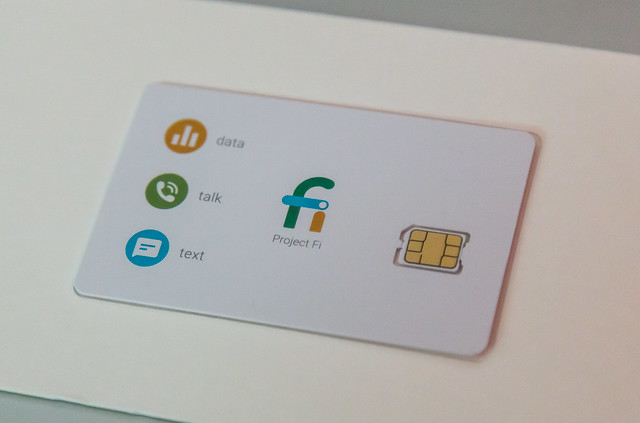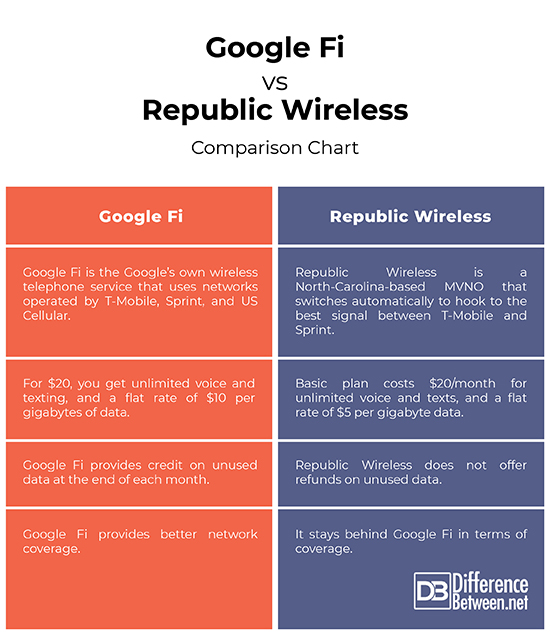Difference Between Google Fi and Republic Wireless
The proliferation of mobile devices such as smartphones and tablets in the recent years has caused a significant and sustained increase in mobile data traffic. In 2015 alone, global mobile data traffic grew by 74% from 2.1 to 3.7 exabytes. And the existing networks are not well suited for the exceedingly large number of devices that are either connected or going to be connected wirelessly to the IoT applications and machine-to-machine communications. Despite the quality of services provided by the new networks, user demand is beginning to exceed their capabilities. To meet the today’s challenging requirements, a mere evolution of the current networks in not sufficient. Instead a new revolution of technologies in the telecommunications landscape is needed.
This is where the next iteration of telecommunications services such as Google Fi and Republic Wireless come to the picture. Both are alternate wireless carriers that help to form a more seamless use of cellular networks and Wi-Fi to offer voice, text messaging, and data services. Google Fi, as the name suggests, is the mobile communications service by search giant Google. Unlike the traditional wireless carrier operators, they do not own the physical wireless carrier infrastructures, but instead lease these carrier infrastructures from the carrier operators to offer new wireless services independently. Let’s see how the two wireless service providers stand up to each other.
Google Fi
Google Fi is the wireless network carrier operated by Google that provides a more seamless use of cellular network and Wi-Fi to offer voice, text messaging, and data services. Formerly Project Fi, Google Fi was announced in 2015 as Google’s very own wireless telephone service, which resells existing network services, routing a user’s call to the best available network at any time without disruption. It allows subscribers to shift intelligently between the three dominant 4G LTE networks – T-Mobile, Sprint, or US Cellular – providing the highest-quality connection and enable communication across networks and devices. Google Fi is technically a mobile virtual network operator (MNVO) which takes advantage of low prices and a technology that effectively combines the classic mobile network with Wi-Fi.
Republic Wireless
Republic Wireless is yet another MVNO based in Raleigh, North Carolina. It switches automatically to hook to the best signal between the two national cellular networks T-Mobile and Sprint. Like Google Fi, it also combines cellular network with Wi-Fi to offer cellular services such as voice, text messaging, and mobile data. It automatically switches back to a mobile wireless network, if the W-Fi is not available. By leveraging and integrating access to supplementary networks, it can support a greater volume of network traffic without any network congestion. It was created in 2010 as a subsidiary of Bandwidth, Inc. (then Bandwidth.com), a global communications and VoIP service company.
Difference between Google Fi and Republic Wireless
Coverage for Google Fi vs. Republic Wireless
Google Fi is the Google’s very own wireless telephone service which banks on existing network services leveraging the best network available at any time. It allows users to switch intelligently between T-Mobile, Sprint, and US Cellular networks to provide seamless network coverage at more places at any time without disruption. Republic Wireless is yet another wireless network carrier that switches automatically to hook to the best signal between T-Mobile and Sprint. Google Fi clearly has the upper hand here, in terms of coverage, as it uses three major US cellular networks.
Pricing
– Google Fi aims to keep things simple by providing the best plan for everything called the Fi Basics. For $20, you get unlimited voice and texting, and a flat rate of $10 per gigabytes of data until you hit 6GB ($60) limit for the month. You also get the credit for the unused data at the end of each month. Republic Wireless plans start at $15 per month for unlimited talk and text messages, and a flat rate of $5 per gigabytes of data. The additional 1GB of data will cost you $30 with Google Fi and $20 with Republic Wireless, but without any credit on unused data.
Phones
– Republic Wireless offers the leading Android smartphones to fit all your needs, starting from as low as $99 for the Moto E, all the way up to the Samsung’s Galaxy series smartphones, and everything in between. Google Fi, on the other hand, is very limited on phone selection with only a few devices under its portfolio. It has an extensive selection of the Nexus devices, though, including the Pixel 3 and Pixel 3 XL. However, neither of the MVNOs was able to bring an iPhone over to their networks, at least for now.
Performance of Google Fi vs. Republic Wireless
– There is nothing impressive to say about the two wireless network carriers and at the same time, there aren’t any bad experiences either regarding customer service and support. Both are quite good at offerings and perks, and provide excellent customer support. Google Fi is all grown up now, since it removed one of its biggest restrictions – the phone selection. Now subscribers can use just any smartphone and start using it with Google Fi, including an iPhone, using the Google Fi iOS app.
Google Fi vs. Republic Wireless: Comparison Chart
Summary of Google Fi vs. Republic Wireless
Both are alternate wireless carriers that help to form a more seamless use of cellular networks and Wi-Fi to offer voice, text messaging, and data services. Google Fi clearly has the upper hand in network coverage as it uses three of the nation’s leading network carriers to provide the highest-quality connection possible. But it’s very limited on its phone selection category, and this is where Republic Wireless leads the competition as it offers the leading Android phones to fit all your needs. Both provide excellent customer support though. Well, at the end of the day, the choice between the two comes down to personal preferences.
- Difference Between Caucus and Primary - June 18, 2024
- Difference Between PPO and POS - May 30, 2024
- Difference Between RFID and NFC - May 28, 2024
Search DifferenceBetween.net :
Leave a Response
References :
[0]Wong, Vincent W.S, et al. Key Technologies for 5G Wireless Systems. Cambridge: Cambridge University Press, 2017. Print
[1]Smyrnaios, Nikos. Internet Oligopoly: The Corporate Takeover of Our Digital World. Bingley, UK: Emerald Group Publishing, 2018. Print
[2]Matyjas, John D., at al. Spectrum Sharing in Wireless Networks: Fairness, Efficiency, and Security. Boca Raton, Florida: CRC Press, 2016. Print
[3]Image credit: https://commons.wikimedia.org/wiki/File:Republic_Wireless_logo.png
[4]Image credit: https://www.flickr.com/photos/diversey/25109932164



